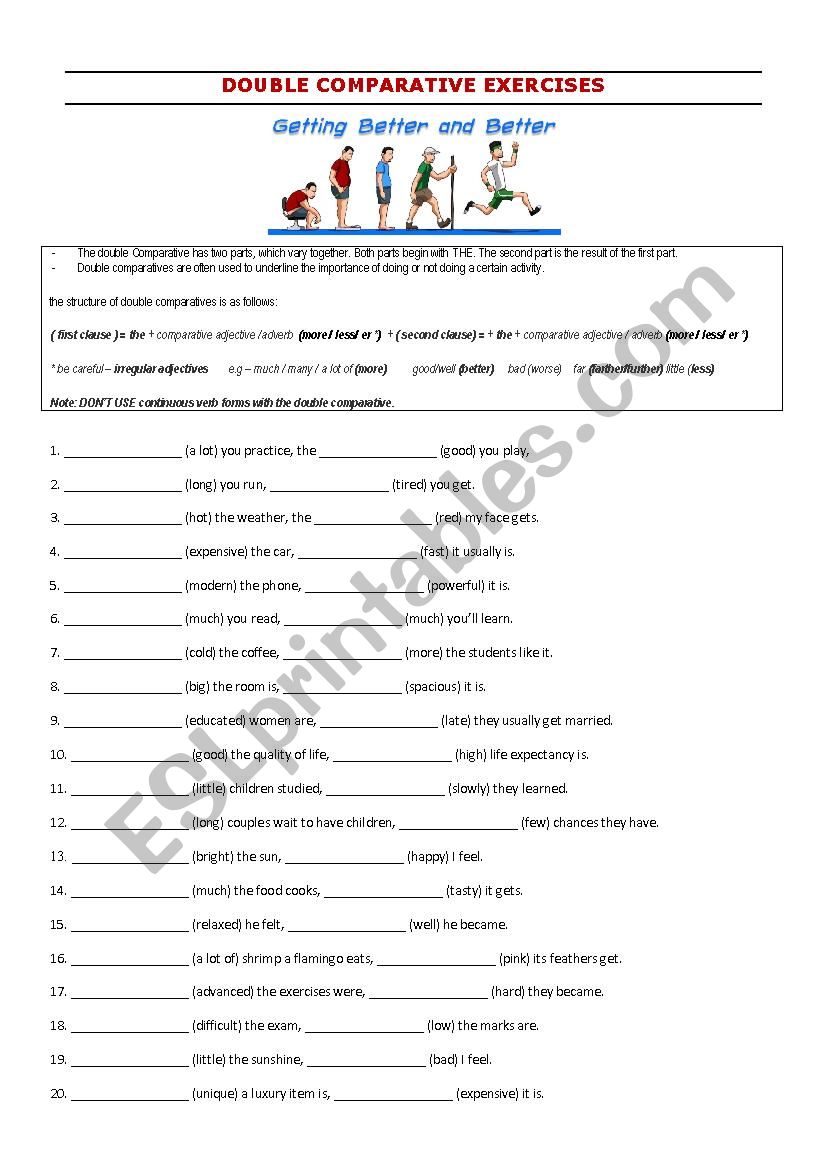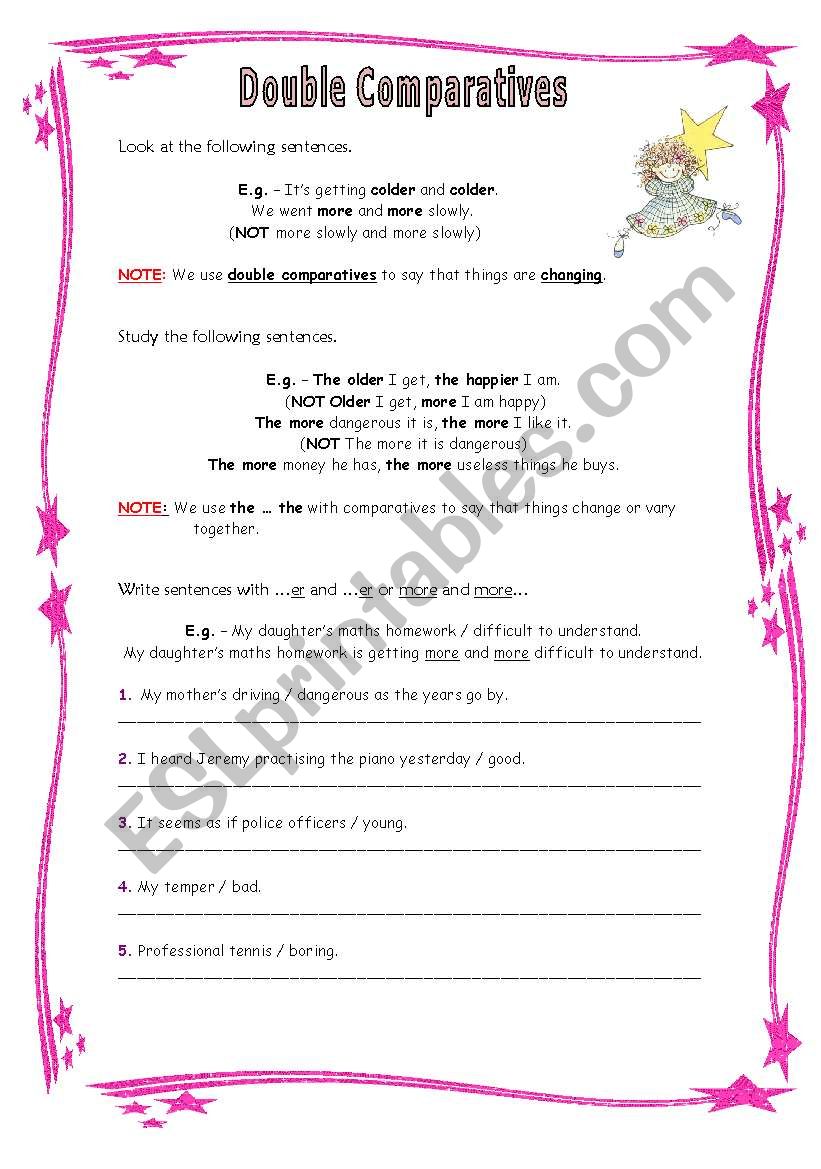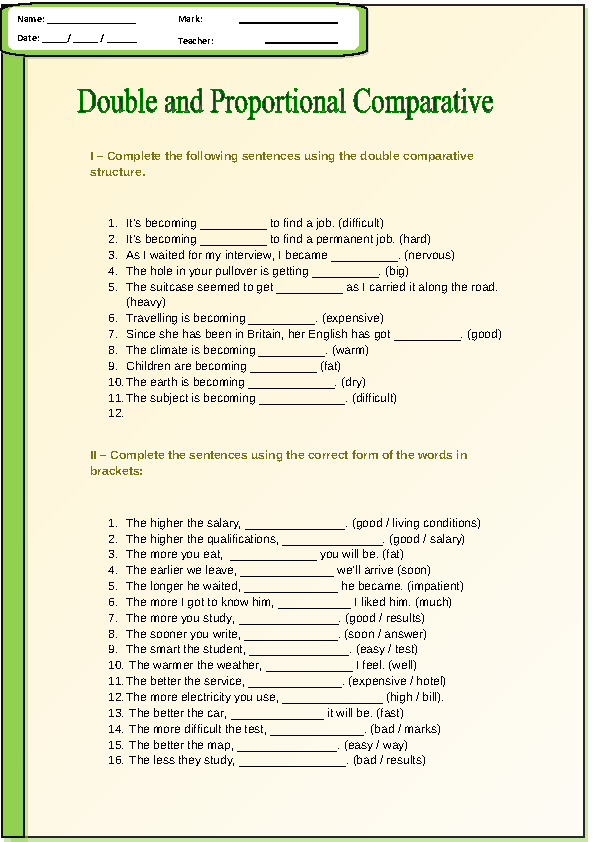
Mastering the Art of Correlation: The Indispensable Role of a Double Comparatives Worksheet
English, a language rich with nuance and expressive power, offers various structures to convey complex ideas. Among these, the "double comparative" stands out as a particularly elegant and useful construction. Phrases like "The more you learn, the more you earn" or "The higher you climb, the colder it gets" exemplify this structure, which is used to express a cause-and-effect relationship or a simultaneous progression between two actions or states. While seemingly straightforward, mastering this grammatical pattern requires dedicated practice and a deep understanding of its intricacies. This is precisely where a well-designed double comparatives worksheet becomes an indispensable educational tool.
Understanding the Double Comparative Structure
Before delving into the importance of a worksheet, let’s firmly grasp what double comparatives are. The structure typically follows the pattern: "The + comparative adjective/adverb + clause, the + comparative adjective/adverb + clause."

- Comparative Adjectives: These are forms like taller, shorter, faster, slower, better, worse, more beautiful, less difficult.
- Comparative Adverbs: These include more quickly, less carefully, sooner, later, harder, softer.




The core function of this structure is to show that a change in one thing is accompanied by a corresponding change in another.
Examples:
- The faster you drive, the more dangerous it becomes. (Speed increases, danger increases)
- The less you worry, the happier you will be. (Worry decreases, happiness increases)
- The older he gets, the more forgetful he becomes. (Age increases, forgetfulness increases)
- The more money she earned, the more she wanted. (Earnings increased, desire increased)


It’s important to note that sometimes the verb can be omitted if it’s clearly implied: "The sooner, the better." (The sooner it happens, the better it will be.) This structure adds a sophisticated layer to English communication, allowing speakers and writers to express proportional relationships concisely and powerfully.

Why a Double Comparatives Worksheet is Essential for Mastery
While theoretical understanding is crucial, the real mastery of double comparatives, like any complex grammatical structure, hinges on ample, structured practice. This is precisely where a well-designed double comparatives worksheet becomes an indispensable educational tool. Here’s why:

-
Structured Practice and Reinforcement: Learners often grasp the concept but struggle with application. A worksheet provides repetitive, controlled exercises that reinforce the pattern. By repeatedly forming sentences, students internalize the "The… the…" structure, the correct use of comparative forms, and the logical connection between the two clauses. This systematic repetition helps move the knowledge from short-term memory to long-term retention.
-
Error Identification and Correction: Worksheets allow students to make mistakes in a low-stakes environment. Teachers can then identify common errors, such as forgetting "the," using superlative instead of comparative forms, or misplacing elements within the clause. For self-learners, an answer key provides immediate feedback, enabling self-correction and deeper understanding.
-
Contextual Application: A good worksheet moves beyond isolated sentences. It presents scenarios or prompts that require students to think about real-world cause-and-effect relationships, making the grammar more meaningful and transferable. For instance, a prompt might ask students to complete sentences related to environmental issues: "The more plastic we use, the…" or "The cleaner the air becomes, the…"
-
Development of Fluency and Accuracy: Consistent practice through a worksheet builds confidence. As students become more accurate with the structure, they also become more fluent in using it naturally in their speaking and writing. This bridges the gap between grammatical knowledge and communicative competence.
-
Diagnostic Tool for Educators: For teachers, a double comparatives worksheet serves as an excellent diagnostic tool. It quickly highlights areas where students are struggling collectively or individually, allowing for targeted re-teaching or differentiated instruction. It also provides tangible evidence of learning progress.
Components of an Effective Double Comparatives Worksheet
A truly effective double comparatives worksheet goes beyond simple fill-in-the-blanks. It incorporates a variety of exercise types to engage different learning styles and solidify understanding from multiple angles.
-
Gap-Fill/Fill-in-the-Blanks:
- Example: The (cold) it gets, the (many) clothes you need.
- Purpose: Basic reinforcement of comparative forms and the "the" article.
-
Sentence Completion:
- Example: The more you practice, the ____.
- Purpose: Encourages students to think about logical cause-and-effect relationships.
-
Sentence Transformation/Rewriting:
- Example: Rewrite using double comparatives: "If you study a lot, you will understand a lot." -> "The more you study, the more you will understand."
- Purpose: Challenges students to convert ideas from one grammatical structure to another, demonstrating deeper comprehension.
-
Matching Exercises:
- Example: Match the first clause to the most logical second clause:
- The louder the music… (a) …the less time you have.
- The less time you spend… (b) …the more money you save.
- The more you save… (c) …the more your neighbors complain.
- Purpose: Focuses on semantic understanding and logical connections.
- Example: Match the first clause to the most logical second clause:
-
Error Correction:
- Example: Correct the mistake: "More money you earn, more taxes you pay."
- Purpose: Develops critical thinking and attention to detail regarding the structure’s rules.
-
Controlled Sentence Creation:
- Example: Create a double comparative sentence using the words "busy" and "tired."
- Purpose: Promotes active construction and creative application within constraints.
-
Open-Ended/Communicative Tasks:
- Example: Discuss with a partner: "The more technology we use, the…" (What are the pros and cons?)
- Purpose: Integrates grammar with speaking, critical thinking, and real-world relevance.
Beyond diverse exercise types, an effective worksheet should feature:
- Clear Instructions: Students should understand exactly what is expected of them.
- Gradual Difficulty: Start with simpler tasks and progressively introduce more complex ones.
- Contextualization: Group exercises around themes (e.g., health, environment, learning) to make them more engaging.
- Answer Key: Crucial for self-study and quick checking in a classroom setting.
Designing Your Own Double Comparatives Worksheet
When embarking on the creation of your own double comparatives worksheet, several pedagogical principles should guide your process to ensure maximum effectiveness:
-
Identify Learning Objectives: What do you want students to be able to do after completing the worksheet? (e.g., correctly form double comparatives, use them to express proportional relationships, identify and correct errors).
-
Target Audience and Level: Tailor the vocabulary and complexity of the sentences to your students’ proficiency level (e.g., A2, B1, B2). For beginners, stick to common adjectives and simple clauses. For advanced learners, introduce more nuanced vocabulary and complex scenarios.
-
Contextualization and Relevance: Make the sentences relatable and meaningful. Instead of random examples, create scenarios that resonate with students’ lives or current events. For example, "The more sleep you get, the more productive you will be." or "The faster the ice melts, the higher the sea levels rise."
-
Authenticity: Use natural-sounding English. Avoid overly academic or stilted language unless that’s the specific aim. Think about how native speakers use these structures in everyday conversation.
-
Scaffolding: Provide support for learners, especially at lower levels. This could mean providing the first word of a sentence, offering word banks for gap-fills, or giving examples for each exercise type.
-
Variety is Key: As mentioned above, include a mix of exercise formats to keep students engaged and test different aspects of their understanding.
-
Pilot Test and Review: Before distributing widely, try the worksheet yourself or with a colleague. Are the instructions clear? Are there any ambiguities? Is the difficulty level appropriate?
Maximizing the Impact of a Double Comparatives Worksheet
The worksheet itself is only one part of the learning process. How it’s used in the classroom or by an independent learner significantly impacts its effectiveness.
-
Pre-Teaching and Review: Before introducing the worksheet, ensure students have a solid grasp of basic comparative adjectives and adverbs. A quick review can prevent common errors.
-
Guided Practice: For initial exercises, work through a few examples together as a class. This models the thought process and clarifies any confusion.
-
Collaborative Learning: Encourage students to work in pairs or small groups. This promotes discussion, peer teaching, and allows students to learn from each other’s mistakes and successes.
-
Post-Worksheet Activities: Don’t let the learning stop when the worksheet is finished. Follow up with:
- Discussion: Have students share their completed sentences or discuss the concepts explored in the worksheet.
- Role-Play/Simulation: Create scenarios where students need to use double comparatives naturally (e.g., "The more you bargain, the lower the price you get").
- Writing Tasks: Assign short paragraphs or essays that require the use of double comparatives to describe trends or relationships.
- Games: Design a game where students have to complete double comparative sentences based on visual prompts or riddles.
-
Constructive Feedback: When correcting worksheets, provide specific, actionable feedback rather than just marking answers right or wrong. Explain why an answer is incorrect and offer suggestions for improvement.
-
Differentiation: For advanced learners, challenge them to create more complex sentences or use a wider range of vocabulary. For struggling learners, provide more support, simpler sentences, or focus on one aspect of the structure at a time.
Conclusion
The double comparative structure is a powerful and elegant linguistic tool that adds depth and sophistication to English communication. Its mastery, while seemingly daunting, is made significantly more accessible and robust through the consistent and thoughtful use of a well-crafted double comparatives worksheet. By providing structured practice, facilitating error correction, and encouraging contextual application, these worksheets serve as invaluable resources for both educators and independent learners. They transform abstract grammatical rules into practical, usable language, paving the way for more fluent, accurate, and expressive English communication. Embrace the power of the worksheet, and watch your understanding – and your students’ understanding – of this fascinating grammatical pattern deepen.
